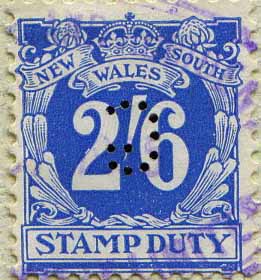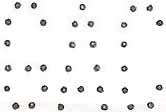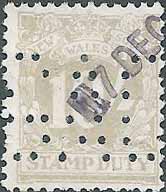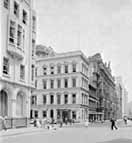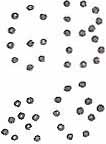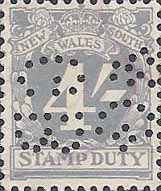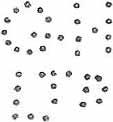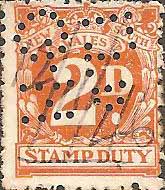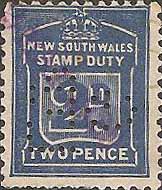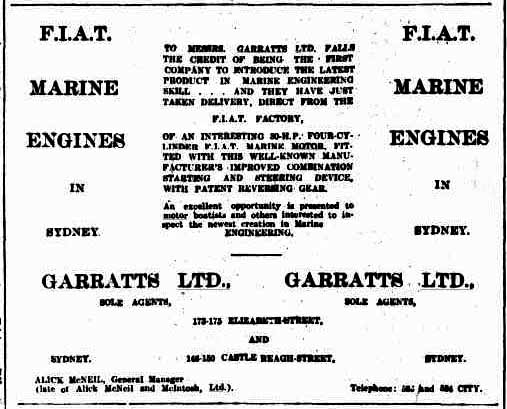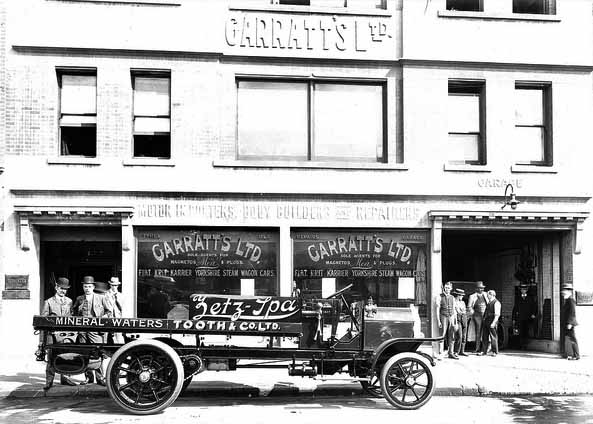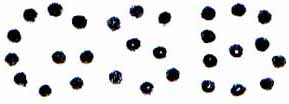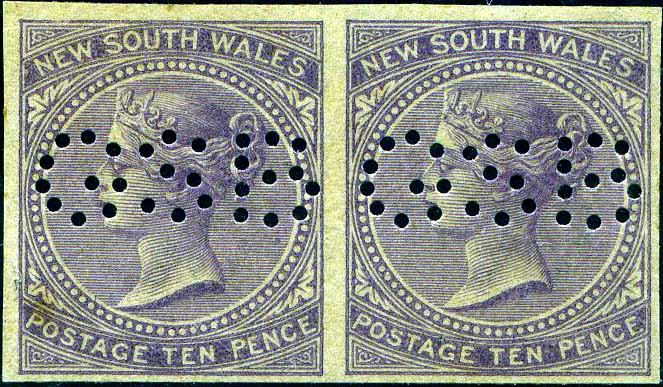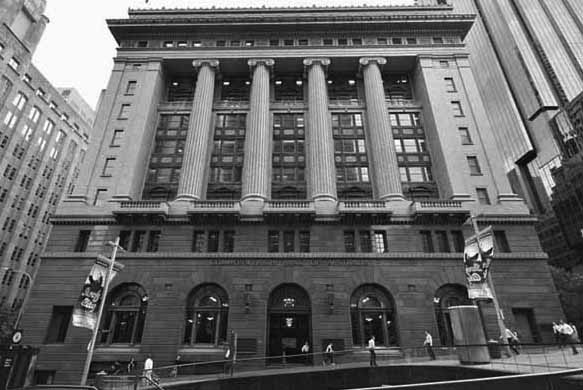|
Private Revenue Perfins of New South Wales An Elsmore Coath production The authors would welcome your comments additions or input into this work A B C D E F G H I J K L M N O P Q R S T U V W Y Other G -------------------------------------------------------- G.a User: Gresham Fire & Accident Insurance Society Ltd Insurance Provider Address: 8-18 Bent, Sydney, NSW Revenue Use: Numeral 1929-66 issue 3d, 6d, 9d, 1/6, 2/-, 2/6, 3/-, 4/-, 5/-, 6/-, 8/-, 10/-, £1, 30/- Decimal 1966 5c, 15c, 25c, 90, $1, $2,
$3 Rarity Scale: Numeral 1929-66 issue 3d R2, 6d R4, 9d R4, 1/6 R4, 2/- R3, 2/6 R4, 3/- R4, 4/- R4, 5/- R4, 6/- R2, 8/- R4, 10/- R4, £1 R4, 30/- R4 Decimal 1966 5c R4,
15c R4, 25c R4, 90c R4, $1 R3, $2 R4, $3 R4 Background: Gresham Fire and Accident Insurance Society was formed in London in 1910 as a sister company to Gresham Life Assurance Society which had been founded by Sir Thomas Gresham in 1848. In June 1912 they opened a branch office in Sydney as Gresham Fire and Accident Insurance Society, Limited. In 1934 the parent company Gresham Life Assurance and Gresham Fire and Accident, and their overseas branches, were acquired by the English Insurance Company, Legal & General. The Gresham acquisition was important for Legal and General as they were based solely in England at this stage and the Gresham's fire insurance business in Australia, provided a base from which Legal & General could establish itself in the Australian market. The trading name of Gresham Fire and Accident Insurance was retained and in fact the G.a device did not come into service until some considerable time after the acquisition. Examples of the pattern are found with Legal and General cachets from 1958-1966.
Device: The pattern is only found used on the revenue stamps of NSW and its format and style of letters is similar to that of other devices.
The pattern seems to have been made by a single die device, as all the strikes that we have seen are identical, and multiple strikes of the same pattern do not show any consistent relationship to each other.
Related patterns: Refer to other Legal & General related company patterns in:
NSW: BC.a CIC.a LG.a -------------------------------------------------------- GAC..a
User: Guardian Assurance Co Ltd Insurance Provider
Address: From 1953: Cnr Pitt (34a-36) & Hunter St’s (97-99) Sydney, NSW
From 1960: ‘Temple House’ 2 Bligh St, Sydney, NSW Revenue Use: Numeral 1929-66 issue 3d, 6d, 9d, 1/-, 1/6, 2/-, 2/6, 3/-, 4/-, 5/-, 6/- 8/-[brown], 10/-, 14/- £1, 30/- Decimal 1966 2c, 3c, 5c, 10c, 15c, 80c, $2, $3, Rarity Scale: Numeral 1929-66 issue 3d R3, 6d R3, 9d R3, 1/- R3, 1/6 R3, 2/- R4, 2/6 R3, 3/- R3, 4/- R3, 5/- R3, 6/- R4, 8/-[brown] R4, 10/- R3, 14/- R4, £1 R3, 30/- R4 Decimal 1966 2c R4, 3c R3, 5c R4, 10c R3, 15c R4, 80c R4, $2 R4, $3 R4 Background: *The Company was originally established in England in 1821 as Guardian Fire & Life and they first arrived in the Australian market in 1876. In 1902 the company was renamed the Guardian Assurance Company. Despite the name, which suggests a company only offering Life Assurance, they also offered Accident, Marine, General Insurance products. The head office of the company in Australia was always in Melbourne but they had branch offices in Sydney, Brisbane, Perth Adelaide and Hobart. In 1953 the company secured a new office for its Sydney branch by purchasing the property at Hunter & Pitt St’s. The company did not stay their long as by 1960 they had moved to ‘Temple Court’ at Bligh St.
Hunter & Pitt St In Australia Guardian Assurance Co Ltd, also traded as Caledonian Insurance Co, The Licensees and General Insurance Co Ltd, The Reliable Marine Insurance Co Ltd, Guardian Life Assurance Co of Australia, Union Insurance Society of Canton Ltd, and British Traders Insurance Co. In 1968 Royal Exchange and Guardian Assurance merged to become Guardian Royal Exchange (GRE) Insurance, which at the time was Britain's fifth largest composite insurer. In the eighties the company was re badged as AXA Insurance. Device: This is another pattern, which is only found used on revenue stamps of NSw. The usage is between 1958 and late 1966. The pattern is quite large and does not suit the size of the contemporary NSW numeral and later decimal issues. In fact it would be nearly impossible to fit the entire pattern onto one of the small NSW revenue stamps and for this reason the pattern is almost always found as a partial.
Such a large format pattern would be understandable if the device was intended as a canceller but this is not the case as examples on piece indicate that the stamps were perforated prior to being affixed to documents. Related Patterns: Refer to other Atlas, Royal Exchange and related company patterns in: NSW: A.a A.b A.c A.d BEA.a REA.a REA.b SAC.a Other – Section 2 Commercial Overprints A(Atlas).a Royal/Exchange/Assurance.a State/Assurance/Co Ltd.a QLD: A.a *Trove
AXA web site -------------------------------------------------------- GB/&Co.a
User: Gibbs Bright & Co Shipping & Trading Address: 37 Pitt St, Sydney, NSW Revenue Use: Numeral 1917-28 issue 2d Numeral 1929-66 issue 3d, 1/6, 2/-, 2/6, 4/-, 5/-, 10/-, £1 Decimal 1966 1c, 3c, 5c Rarity Scale: Numeral 1917-28 issue 2d R4 Numeral 1929-66 issue 3d R4, 1/6 R4, 2/- R4, 2/6 R4, 4/- R2, 5/- R4, 10/- R3, £1 R3 Decimal 1966 1c R4, 3c R4, 5c R4 Background: *The founder of Gibbs Bright and Co was Antony Gibbs, born in Exeter in 1756. After schooling at Exeter Grammar School he took a position in 1774 as a woolen cloth trader with a firm trading mainly in Spain. He had a series of ventures in cloth trading and milling in his own right as well as in conjunction with his brother Abraham and with financial support from his father. By 1808 he had ceased milling and decided to start his own cloth trading business as Antony Gibbs and Son. He did this with some support from his brother George who had a shipping business.
Anthony died in 1815 but the company continued to grow under his sons Henry and William and cousin Charles Crawley who expanded into the new markets of the independent countries that had been Spanish South America. The company evolved into a more general trading company trading in resources such as fertilisers and this in turn lead to expansion into the allied businesses such as banking, financing, insurance, exporting, marketing, and shipping.
In 1843 Henry’s eldest son Henry (jnr) joined the company and he remained its head until his death in 1907. This period was one of considerable prosperity for the company and it saw it expand into Australia in 1881 through the acquisition the firm of Gibbs, Bright and Company, (also known as Bright Brothers and Co) a company that Antony's brother George had helped to develop between 1789 and 1818. It had originally been located in Bristol, its main office had been transferred to Liverpool in 1805 but in 1887 the administration was centred in London.
Gibbs, Bright and Company had principally been involved in shipping and trading, mainly in the West Indies, but following the discovery of gold in Victoria they established an office in Melbourne and soon became one of the leading shipping agents and merchants in the Colony. They expanded into passenger shipping and soon established offices in Brisbane, Sydney, Newcastle, Adelaide and Perth as well as launching passenger services between England, Mauritius and New Zealand.
Gibbs, Bright also held a number of financial agencies from British mortgage, finance and investment companies as well as representing several British insurance companies in Australia. In addition they conducted a growing import business as well as an export business that included livestock, dairy produce, wool and flour. Also the company played a substantial part in the development of Australia's mineral resources, starting with lead in 1895, and later venturing into tin, gold, copper, cement and super phosphates.
In Australia, after WWI, many of the larger companies were managing their own import and export so Gibbs, Bright and Company tended to focus its Agency business on smaller companies while expanding their interest into other markets such as timber, wire netting, zinc, stevedoring, road transport, marine salvage, gold mining as well as mechanical, structural, electrical and marine engineering. The companies shipping interests continue to grow as well and still formed a major part of its business.
In 1948 the parent company in England took the major step from tradition when they changed the business from a partnership into a private limited company. The name was the same, Antony Gibbs and Sons Limited, and in practice the effect of the change was very little. Some of the firm's branches and departments had already become limited companies and the formation of a parent company simplified the structure. The Australian operation was in time changed to Gibbs Bright & Co Pty Ltd in 1963.
Device: The GB/CO.a device was most likely a single die device as the strikes that we have seen are all identical and we can find no evidence of consistently related strikes.
The pattern is only found on the revenue stamps of NSW and only in the period from the early 1960’s until at least 1966.
Most cachets found with these patterns are not dated and this makes accurate dating of the device use difficult.
Related patterns: Nil * https://www.gibbsbrightclub.org/ -------------------------------------------------------- GH/LTD.a
User: George Hudson Pty Ltd Timber Merchants & Joiners, later Home Builders Address: 1 Bridge Rd, Blackwattle Bay, Glebe, NSW Revenue Use: Numeral 1917 issue 2d Numeral 1918-28 issue 2d Numeral 1929-66 issue 2d Rarity Scale: Numeral 1917 issue 2d R4 Numeral 1918-28 issue 2d R4 Numeral 1929-66 issue 2d R4 Background: *Carpenter William Henry Hudson, immigrated to Sydney from England in 1846. He established a joinery company in Redfern around 1855 and during the 1870s this venture expanded to include engineering and this necessitated the establishment of new premises in Clyde near Parramatta. William's son George also joined the company and he took control of the joinery business in Redfern, The Company became George Hudson & Son.
George
Hudson & Son were pioneers in pre fabrication
and produced doors, windows and other timber
building elements. By 1870 Hudsons's joinery in
Redfern was able to produce 500 pairs of sash
windows and 200 doors per week. The resulting
economy of scale made building components cheaper
and served to reduce the price of homes overall.
Around 1900 the company began to produce partially
prefabricated timber houses and in 1905 the
company became a public company as George Hudson
& Son Ltd.
Device: The GHLTD.a device was most likely a single die device as it produces central strikes on a range of formats of postage and revenue stamps.
The device was in service between 1927 and 1946 and the pattern is found on both the postage stamps of Australia and revenue stamps of NSW. Interesting the usage on postage stamps seems to stop around 1939 and later usage is limited to revenue stamps only. Related Patterns: Nil
-------------------------------------------------------- G/LTD...a
User: Garrett's Ltd Motor Vehicle Importers (agents for Fiat) Address: Block with frontages at: 173-175 Elizabeth St, Sydney, NSW 148-150 Castlereagh St, Sydney, NSW Revenue Use: Numeral 1917 issue 2d Rarity Scale: Numeral 1917 issue 2d R4 Background: Garratt’s Limited started out as a Motor Body Works on the corner of Dowling and William St's in Darlinghurst in the early 1900’s and it is possible that they may have been a Coach Builder before that time.
The pattern is found on the revenue stamps of NSW as well as the postage stamps of Australia.
By 1911 they had secured the agency for FIAT trucks and around this time they also established substantial premises in Elizabeth and Castlereagh St's in Sydney. Later they offered FIAT cars as well as those of the DORT Company of Michigan, USA, and other trucks by GUY (UK), Sterling (subsidiary of Daimler USA) and Duplex (Michigan, USA).
The company continued to trade into the 1920’s and expanded its range of new vehicles to include the US built 'Graham' by the early 1930’s as well as a range of other imported cars and trucks and second hand vehicles. The company was still trading in the early 1950’s.
Device: The GLTD.a device is most likely a single head device as it produces central strikes on a range of formats of postage and revenue stamps.
Evidence from usage on postage stamps indicates that the device was in service between 1914 and 1927 but examples used on revenues are so scarce that it is difficult to confirm the exact usage period for revenues. Related Patterns: Nil -------------------------------------------------------- GSB.a
User: Government Savings Bank of NSW Bank Address: Moore St, Sydney, NSW From 1891, 48 Martin Pl, Sydney, NSW Revenue Use: QV Postal Fiscal 10d Rarity Scale: QV Postal Fiscal 10d R4 Background: The Government Savings Bank of New South Wales was incorporated in 1907 in order to provide a Government Bank to absorb the regional banks that had been established throughout the NSW since 1871 by the NSW Post Office. The Post Office needed to separate off it's non postal activities as it's operations were being taken over by the Commonwealth Post Master Generals Department.
In 1931 the Government Savings Bank and much of its associated Rural Bank, were amalgamated into the operations of the Commonwealth Bank of Australia. At this time the Commonwealth Bank also absorbed the State Savings Bank of Western Australia. The remainder of the Rural Bank's business was transferred to the Rural Bank of New South Wales in 1932.
The Commonwealth Bank of Australia (later CBC) had been founded by the Commonwealth Bank Act in 1911 and it was the first bank to receive a Federal Government guarantee. From 1920 the CBC acted as the Central Bank in Australia, which included the issuing of bank notes however this was a controversial role.After absorbing the Government Savings Bank of New South Wales, CBC went on to become one of the dominant banks in Australia. In the late 1950’s the controversy regarding the dual roles of the bank was addressed by the creation of the Reserve Bank of Australia, which took over the central bank functions leaving the CBC with just its commercial banking functions.
These functions were undertaken by the CBC’s constituent banks, the Commonwealth Trading Bank of Australia (CTB), the Commonwealth Savings Bank of Australia (CSB) and the newly formed Commonwealth Development Bank (CDB).
In 1989 the bank acquired a controlling interest in the ASB Bank of New Zealand and in 1991 CBC took over the State Savings Bank of Victoria. Between 1991 and 1996 the Australian government fully privatised the CBC into a publicly listed company.
Device: The GSB.a device was a multi die device of approximately 12 heads in a horizontal array with a regular separation of approximately 25 mm between die heads. The dies are essentially identical so we list it as a single pattern.
The device came into use in January 1907 and the puncturing was done by the New South Wales Government Printer.
Initially the pattern was larger and appeared as GSB/NSW but by March 1907 this was altered to be just GSB as such a pattern with so many holes was not suitable for the small format NSW postage and revenue issues of the time.
Only the later GSB.a format is found on revenue stamps.
The device was used until about 1911. Related Patterns: Nil
-------------------------------------------------------- A B C D E F G H I J K L M N O P Q R S T U V W Y Other © copyright 2011 |

